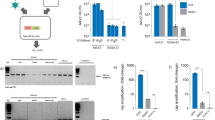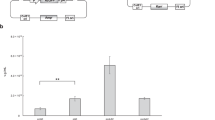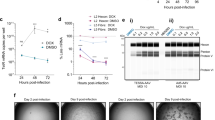Abstract
It has been difficult to produce a chimeric vector containing both Ad and AAV rep and cap, and to grow such chimeric vectors in 293 cells. By recombination in vitro in a bacterial host, we were able to produce recombinant plasmid AdAAV (pAdAAVrep-cap), which could be used to generate recombinant AdAAV (rAdAAVrep-cap) after transfection into 293 cells. A recombinant adenovirus, rAdAAVGFP, in which the green fluorescent protein (GFP) gene is flanked by the AAV terminal repeats cloned into the E1-deleted site of Ad was also generated. Co-infection of rAdAAVrep-cap together with rAdAAVGFP into 293 cells resulted in production of high titers of rAAV expressing GFP. It was noted that the titer of rAdAAVrep-cap was lower than the titer of control AdCMVLacZ. The lower titer of rAdAAvrep-cap was associated with expression of Rep protein. Non-homologous recombination occurs after high passage and results in deletions within the AAV rep genes. These results indicate that (1) rAdAAVrep-cap can be produced; (2) rAdAAVrep-cap + rAdAAVGFP is a convenient and efficient way to transfect 293 cells to grow high titer rAAV; and (3) frozen stock is required to avoid propagation of rep-deleted pAdAAVrep-cap.
This is a preview of subscription content, access via your institution
Access options
Subscribe to this journal
Receive 12 print issues and online access
$259.00 per year
only $21.58 per issue
Buy this article
- Purchase on Springer Link
- Instant access to full article PDF
Prices may be subject to local taxes which are calculated during checkout






Similar content being viewed by others
References
Kotin RM, Linden RM, Berns KI . Characterization of a preferred site on human chromosome 19q for integration of adeno-associated virus DNA by non-homologous recombination EMBO J 1992 11: 5071–5078
Grimm D, Kleinschmidt JA . Progress in adeno-associated virus type 2 vector production: promises and prospects for clinical use Hum Gene Ther 1999 10: 2445–2450
Yan Z, Zhang Y, Duan D, Engelhardt JF . Trans-splicing vectors expand the utility of adeno-associated virus for gene therapy Proc Natl Acad Sci USA 2000 97: 6716–6721
Sun L, Li J, Xiao X . Overcoming adeno-associated virus vector size limitation through viral DNA heterodimerization Nat Med 2000 6: 599–602
Nakai H, Storm TA, Kay MA . Increasing the size of rAAV-mediated expression cassettes in vivo by intermolecular joining of two complementary vectors Nat Biotechnol 2000 18: 527–532
Berns KI, Linden R . The cryptic life style of adeno-associated virus Bioessays 1995 17: 237–245
Ferrari FK, Samulski T, Shenk T, Samulski J . Second-strand synthesis is a rate-limiting step for efficient transduction by recombinant adeno-associated virus vectors J Virol 1996 70: 3227–3234
Wang XS, Ponnazhagan S, Srivastava A . Rescue and replication signals of the adeno-associated virus 2 genome J Mol Biol 1995 28: 573–580
Xiao X, Li J, Samulski RJ . Production of high-titer recombinant adeno-associated virus vectors in the absence of helper adenovirus Virol 1998 72: 2224–2232
Gao GP et al. High-titer adeno-associated viral vectors from a Rep/Cap cell line and hybrid shuttle virus Hum Gene Ther 1998 9: 2353–2362
Clark KR, Voulgaropoulou F, Fraley DM, Johnson PR . Cell lines for the production of recombinant adeno-associated virus Hum Gene Ther 1995 6: 1329–1341
Clark KR, Voulgaropoulou F, Johnson PR . A stable cell line carrying adenovirus-inducible rep and cap genes allows for infectivity titration of adeno-associated virus vectors Gene Therapy 1996 3: 1124–1132
Fisher KJ, Kelley WM, Burda JF, Wilson JM . A novel adenovirus-adeno-associated virus hybrid vector that displays efficient rescue and delivery of the AAV genome Hum Gene Ther 1996 7: 2079–2087
Casto BC, Atchison RW, Hammon WM . Studies on the relationship between adeno-associated virus type1 (AAV-1) and adenoviruses Virol 1967 2: 52–57
Brister JR, Muzyczka N . Rep-mediated nicking of the adeno-associated virus origin requires two biochemical activities, DNA helicase activity and transesterification J Virol 1999 73: 9325–9336
Wu J, Davis MD, Owens RA . Factors affecting the terminal resolution site endonuclease, helicase and ATPase activities of adeno-associated virus type 2 Re proteins J Virol 1999 73: 8235–8244
Zhou X, Zolotukhin I, Im DS, Muzyczka N . Biochemical characterization of adeno-associated virus rep68 DNA helicase and ATPase activities J Virol 1999 73: 1580–1590
Su PF, Chiang SY, Wu CW, Wu FY . Adeno-associated virus major rep78 protein disrupts binding of TATA-binding protein to the p97 promoter of human papillomavirus type 16 J Virol 2000 74: 2459–2465
Weger S, Wendland M, Kleinschmidt JA, Heilbronn R . The adeno-associated virus type 2 regulatory proteins rep78 and rep68 interact with the transcriptional coactivator PC4 J Virol 1999 73: 260–269
Di Pasquale G, Stacey SN . Adeno-associated virus Rep78 protein interacts with protein kinase A and its homolog PRKX and inhibits CREB-dependent transcriptional activation J Virol 1998 72: 7916–7925
Hermonat PL et al. Adeno-associated virus Rep78 inhibits oncogenic transformation of primary human keratinocytes by a human papillomavirus type 16-ras chimeric Gynecol Oncol 1997 66: 487–494
Hermonat PL . Down-regulation of the human c-fos and c-myc proto-oncogene promoters by adeno-associated virus Rep78 Cancer Lett 1994 181: 129–136
Kumar S, Leffak M . Conserved chromatin structure in c-myc 5’flanking DNA after viral transduction J Mol Biol 1991 222: 45–57
Wonderling RS, Owens RA . The Rep68 protein of adeno-associated virus type 2 stimulates expression of the platelet-derived growth factor B c-sis proto-oncogene J Virol 1996 70: 4783–4786
Batchu RB, Shammas MA, Wang JY, Munshi NC . Interaction of adeno-associated virus rep78 with p53: implications in growth inhibition Cancer Res 1999 59: 3592–3595
Zhou C, Yang Q, Trempe JP . Enhancement of UV-induced cytotoxicity by the adeno-associated virus replication proteins Biochim Biophys Acta 1999 1444: 371–383
Recchia AR et al. Site-specific integration mediated by a hybrid adenovirus/adeno-associated virus vector Proc Natl Acad Sci USA 1999 96: 2615–2620
Conway JE et al. Recombinant adeno-associated virus type 2 replication and packaging is entirely supported by a herpes simplex virus type 1 amplicon expressing Rep and Cap J Virol 1997 71: 8780–8789
Conway JE et al. High-titer recombinant adeno-associated virus production utilizing a recombinant herpes simplex virus type I vector expressing AAV-2 Rep and Cap Gene Therapy 1999 6: 986–993
Samulski RJ, Chang LS, Shenk T . Helper-free stocks of recombinant adeno-associated viruses normal integration does not require viral gene expression J Virol 1989 63: 3822
He TC et al. A simplified system for generating recombinant adenoviruses Proc Natl Acad Sci USA 1998 95: 2509–2514
Kok T et al. Comparison of six nucleic acid extraction methods for detection of viral DNA or RNA sequences in four different non-serum specimen types J Clin Virol 2000 16: 59–63
Zhang HG et al. Induction of specific T-cell tolerance by adenovirus-transfected, Fas ligand-producing antigen presenting cells Nat Biotechnol 1998 16: 1045–1049
Hirt B . Selective extraction of polyoma DNA from infected mouse cell cultures J Mol Biol 1967 26: 365–369
Acknowledgements
We thank Dr James Wilson for providing B50 cell line, Dr J Samulski for plasmid psub201, Ad309 and Dr Bert Vogelstein for plasmid DNAs pshuttle, pAdeasy1. We also thank Mr M Spell and Dr T Rogers at the FACS Core Facility at UAB for helping to do the FACS analyses. We also thank M Linda Flurry for excellent secretarial work and Dr Fiona Hunter for editorial assistance. This work is supported by NIH grants R01 AG 11653, RO1-AI-42900, N01 AR 6–2224, and CA20468, and a Birmingham VAMC Merit Review Grant. Huang-Ge Zhang is a recipient of an Investigation award from American Arthritis Foundation, and Hui-Chen Hsu is a recipient of a postdoctoral fellowship from Arthritis Foundation.
Author information
Authors and Affiliations
Rights and permissions
About this article
Cite this article
Zhang, HG., Wang, Y., Xie, J. et al. Recombinant adenovirus expressing adeno-associated virus cap and rep proteins supports production of high-titer recombinant adeno-associated virus. Gene Ther 8, 704–712 (2001). https://doi.org/10.1038/sj.gt.3301454
Received:
Accepted:
Published:
Issue Date:
DOI: https://doi.org/10.1038/sj.gt.3301454
Keywords
This article is cited by
-
AAV9 Vector: a Novel modality in gene therapy for spinal muscular atrophy
Gene Therapy (2019)
-
AAV-mediated delivery of a mutated myostatin propeptide ameliorates calpain 3 but not α-sarcoglycan deficiency
Gene Therapy (2007)
-
Noninvasive monitoring of therapeutic gene transfer in animal models of muscular dystrophies
Gene Therapy (2006)
-
Production and characterization of adeno-associated viral vectors
Nature Protocols (2006)



